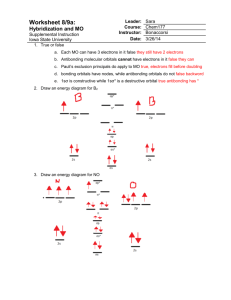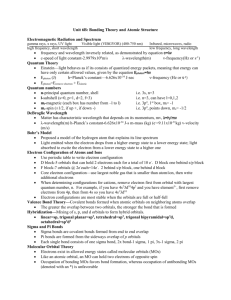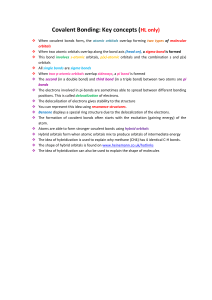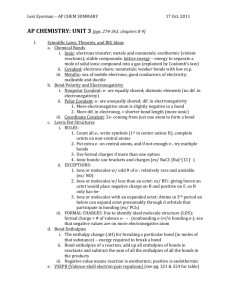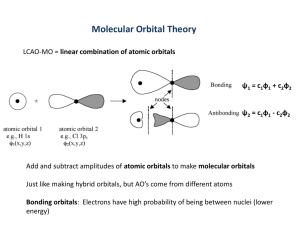NAME: DATE: PERIOD: AP CHEMISTRY – CHAPTER 9 STUDENT
advertisement
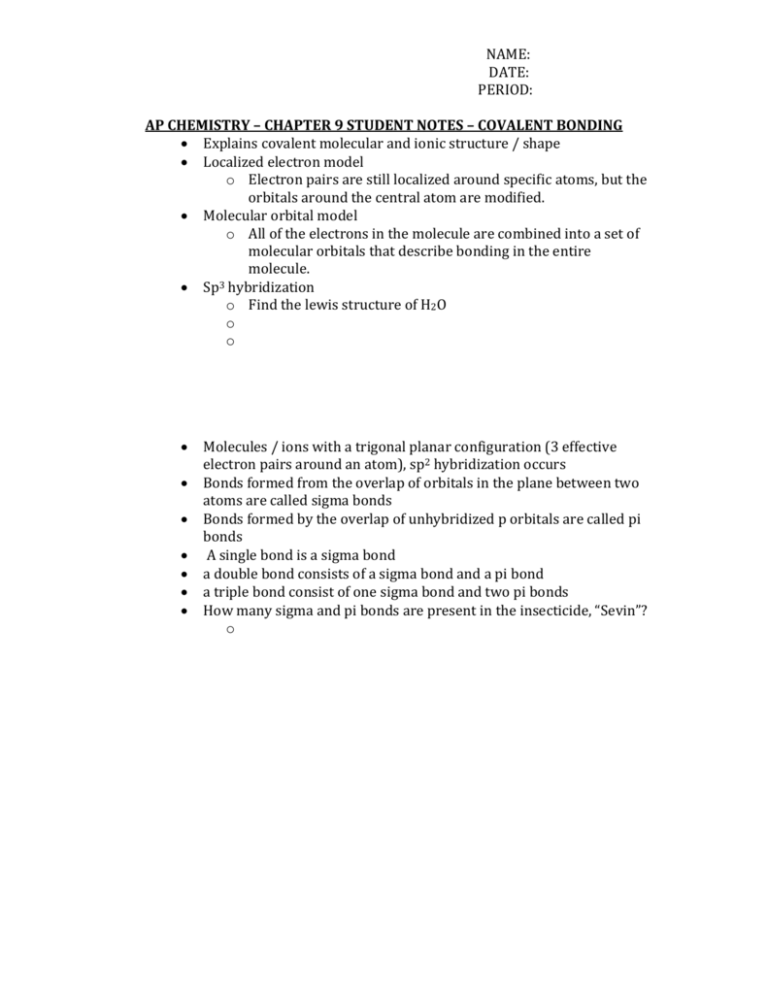
NAME: DATE: PERIOD: AP CHEMISTRY – CHAPTER 9 STUDENT NOTES – COVALENT BONDING Explains covalent molecular and ionic structure / shape Localized electron model o Electron pairs are still localized around specific atoms, but the orbitals around the central atom are modified. Molecular orbital model o All of the electrons in the molecule are combined into a set of molecular orbitals that describe bonding in the entire molecule. 3 Sp hybridization o Find the lewis structure of H2O o o Molecules / ions with a trigonal planar configuration (3 effective electron pairs around an atom), sp2 hybridization occurs Bonds formed from the overlap of orbitals in the plane between two atoms are called sigma bonds Bonds formed by the overlap of unhybridized p orbitals are called pi bonds A single bond is a sigma bond a double bond consists of a sigma bond and a pi bond a triple bond consist of one sigma bond and two pi bonds How many sigma and pi bonds are present in the insecticide, “Sevin”? o NAME: DATE: PERIOD: The hybridization of the orbitals of an atom depends on the total number of effective electron pairs around it. In order to determine the hybridization of an atom, it is essential that you can figure out its VSEPR structure Double and Triple bonds count as only one effective electron pair Example (Practice with Hybrid Orbitals) o IF2+ o OSF4 o SiF62o HCCH Answer the following questions regarding aspartame (Nutrasweet) o How many sigma bonds? o How many pi bonds? o Hybridization of carbon a? Of carbon b? o Hybridization of nitrogen a? Of oxygen a? NAME: DATE: PERIOD: The Molecular Orbital Model o This model deals with molecules with unpaired electrons and bond energies All the valence electrons in a molecule exist in a set of molecular orbitals of given energy The valence electrons of each atom are not acting independently but rather act with other valence electrons to form a set of MO’s. There are bonding and antibonding MO’s. Bonding results in lower energy than if no interaction occurred. Antibonding results in higher energy A molecule will be stable if there is more bonding than antibonding interaction. Bond order is a measure of net bonding interactions BO = (# bonding electrons - # antibonding electrons) /2 BO must be greater than zero for a stable molecule to form The higher the BO, the stronger the bond o Example (MO Theory) H22 H2+ Bonding in Homonuclear Diatomic Molecules o Diatoms containing 2s and 2p orbitals o Sigma bonds form between nuclear centers, MO’s can be formed using 2s orbitals or 2px orbitals o Pi orbitals can be formed by the overlap of both 2py and 2pz orbitals. Also sigma and pi antibonding orbitals exist. o Paramagnetism indicates unpaired electrons in a substance, also causing the substance to be attracted to a magnetic field. o Diamagnetism indicates paired electrons in a substance that causes the substance to be repelled from the magnetic field. o Paramagnetism dominates diamgnetism if both effects are present NAME: DATE: PERIOD: Order for Carbon and nitrogen Order for oxygen and fluorine Filling molecular orbitals from atoms containing 2s and 2p electronic orbitals works the same as when filling form 1s orbitals. Just fill from lowest to highest energy, and remember to fill degenerate orbitals separately, then pairwise with the electrons having opposite spins. Example (Sigma and Pi molecular orbitals) o Determine the following regarding F21 Electron configuration, bond order, para and diamagnetism and the bond energy relative to F2. NAME: DATE: PERIOD: Example (Practice with Sigma and Pi orbitals) o Determine the electron configuration and bond orders for S22- and Cl22-. If they can exist, discuss their magnetism. Bonding in Heteronuclear Diatomic Molecules’ o The MO model for homonuclear molecules works well for describing the bonding in atoms adjacent to one another. The model breaks down with two very different atoms. o Example (Practice with the MO Model) Using the MO model, describe the bonding, magnetism, and relative bond energies in the following species: O2 O21 O22-

